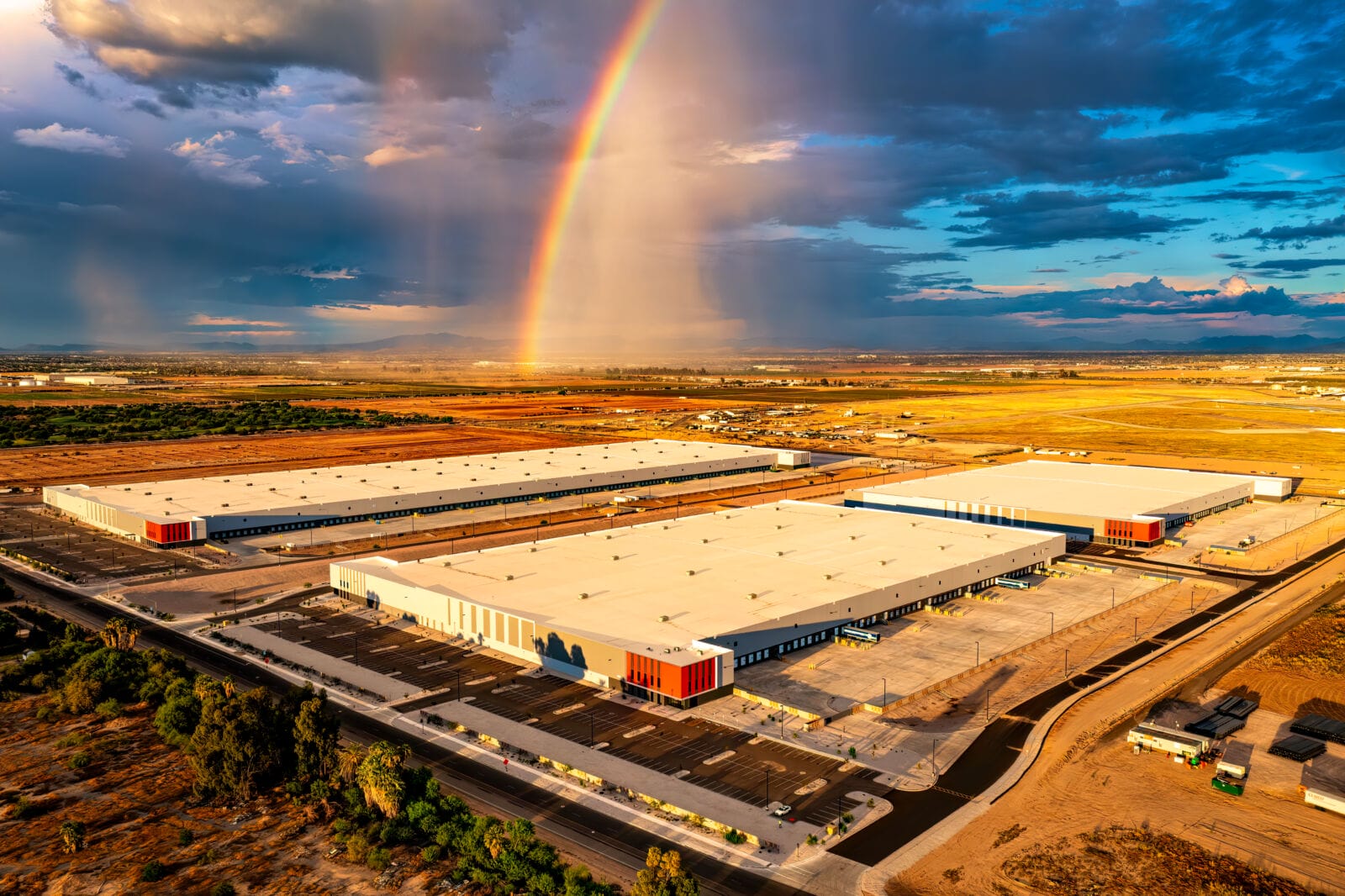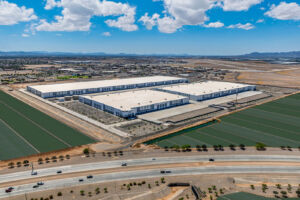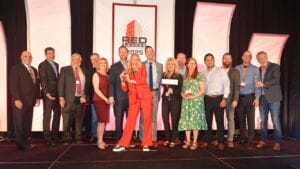Throughout the first half of the decade, Arizona’s construction industry has seen unprecedented growth, with hundreds of billions of dollars in new developments flowing into the state. TSMC Arizona’s $165 billion investment raised the state’s profile as a worthwhile place to do business, and new projects across multiple sectors continue to break ground.
AZRE magazine sat down with four members of the Arizona Builders Alliance (ABA) to learn about what’s happening in the state’s construction industry — the volume of available work, how market dynamics are shifting, the impacts of tariffs, why technology is shaping the future of building and more:
- Chris Kirch, president at Kitchell
- Danielle Puente Torres, president at DP Electric
- Mark Stoller, general manager at GrayWolf
- Nathan Lentz, Arizona business unit leader at DPR Construction
The following has been edited for clarity and length.
AZRE: The construction industry has been busy over the last five years. Has the amount of available work changed at all?
Danielle Puente Torres: From 2022 to 2024, we saw huge spikes in growth, but we’re anticipating revenue in 2025 to be flat. We do see a lot of opportunities coming in 2026 and 2027, even though the first half of this year has been slightly slower. Project sizes are still very large, with lots of hyperscale data centers being built and the semiconductor space continuing to grow, so we expect to get more traction going into the next year.
MORE NEWS: How Arizona data center construction will explode with AI adoption
INDUSTRY INSIGHTS: Want more news like this? Get our free newsletter here
AZRE: Nathan, are you still seeing big developments come to Arizona?
Nathan Lentz: I couldn’t agree more with Danielle. The average size of projects DPR works on now has doubled from what it used to be. We’re fortunate to have these mega jobs in our backyard, but that may skew the numbers of what is true growth versus one-off bursts. Our costs have also gone up, which I’m sure our trade partners are feeling too. As far as volume, we have a steady book of business through the end of 2027.
AZRE: Mark, what’re your thoughts on the state of the construction industry today?
Mark Stoller: Over the last couple of years, there has been a shift in the market. The tilt warehouse space was so busy it was putting a huge constraint on materials and disrupting other sectors. That has changed some with interest rates being what they are, but overall, we’re still seeing growth.
AZRE: Anything you like to add, Chris?
Chris Kirch: Like the others have said, there are still plenty of large-scale jobs going on, but we’re also seeing a change in what is getting built. There aren’t as many big healthcare projects out there compared to the last several years — now it’s mostly renovations and expansions. On the other hand, a lot of construction is happening in Native American communities. As these huge semiconductor and data center developments finish up, more will need to be built to support that growth. So, I think Arizona has a strong, diverse market. If one sector is down, another is up, which carries the industry forward and keeps us all busy.
AZRE: Danielle, you mentioned DP Electric’s workload has plateaued compared to the last few years. Is a slowdown concerning when you know more jobs are coming in 2026?
DPT: We’re a growth-minded organization, so we’ll always strive for that. But having one flat year to catch our breath is not the worst thing. Right now, the focus is on training and improving our processes — which are hard to do when things are hectic. That will make us even more prepared to tackle the opportunities ahead.
NL: Just to add to Danielle’s point — nobody wants the growth chart to look like an EKG monitor. There’s always the push and pull of being strategic, following the right leads and ensuring everything aligns with business needs. As a self-performing general contractor, we have a large craft workforce. We don’t want these up-and-down spikes of job activity, because that causes releases. Danielle is right — all our companies are focused on growing, but we want to be strategic and not just let the market pull us.
AZRE: When it comes to challenges facing the construction industry, the most talked about one right now is tariffs. Have they had any effect on business, Mark?
MS: It has created uncertainty. Some of our material suppliers were expecting the worst-case scenario, and we saw prices spike at the beginning of the year. Articles always get written when costs go up, but there aren’t as many when they go down — and we have seen some softening. That still causes uncertainty though, which leads to more time spent on bidding before projects move forward. We always try to keep our clients informed about strategies or workarounds to avoid longer schedules and added costs by bringing other solutions to the table.
AZRE: Danielle, have tariffs caused any disruptions in your work?
DPT: As far as actual cost impact, we haven’t seen much because it’s still all speculation. Clients are always asking us this question, but it’s hard to quantify right now. But the ambiguity of the situation has been a challenge.
AZRE: Have the tariffs, or the instability they cause, been a setback for DPR?
NL: There’s a lot of guessing going on out there about what this could grow into. Will we need to change our procurement process? How will it affect the end product? With all the unknowns, we’re consuming as much information as possible so we can respond responsibly to our clients and trade partners.
AZRE: Anything you’d like to add regarding tariffs, Chris?
CK: The others covered it well, but I want to mention that our industry learned a great deal navigating through the pandemic. To Nathan’s point, it’s all about transparency with our clients, trade partners and internally. That communication helps us all go in the same direction. There’s uncertainty, but we have to move forward with projects and be open minded on how to approach problems as they come up.
MS: I’d like to add that even though tariffs are the hot topic, there are other problems that need to be solved to keep Arizona growing. Water issues will affect how much we can continue to expand, especially in the Valley. There are other environmental concerns too. Maricopa County just avoided a potential hurdle regarding air quality, but it’s not over — just delayed. Power is also critical. Data centers have significant energy requirements. How long until that starts affecting the average consumer?
NL: What’s great about this conversation is that it’s a great example of why the Arizona Builders Alliance and other organizations are so important. It’s about building partnerships — not just having our company names on a wall but taking action as an industry. None of the issues Mark brought up can be solved by a single person or company.
CK: I agree. Talking about our struggles and celebrating our successes is how we become better as an industry. And I think there’s more transparency now than ever. We’re all facing the same issues, so we might as well try to solve them together.
AZRE: Well said everyone. Is there anything else you all would like to leave readers with?
DPT: I think the Valley still hasn’t reached the level of some of the other big cities. At DP Electric, our goal is to diversify regionally, which is why we branched out into Texas last year. Having a bigger footprint will help us as the market shifts, because no one really knows what will happen in Arizona in the long term. But we’re just starting out on that journey. I’d also like to add that I’m hopeful about the next generation. When it comes to technology, they will help us navigate those changes. The emotional intelligence and leadership capacity I see in young people makes me confident that we can handle the challenges that arise in the future.
MS: The incredible growth happening in Arizona’s construction industry can be traced back to projects like TSMC and others that showed we have a favorable building environment. The challenge will be to maintain those conditions that allow companies to come here and develop projects that pencil out. They’ll need water, power and a workforce, and our industry should do what we can to help meet those needs.
NL: The tools of the trade are changing. Today, we’re armed with iPads and augmented reality to best serve our customers, because everyone wants the work done faster without sacrificing quality. We have to evolve as the market does, and that means educating the next generation. But we also need to remember our obligation to the craft workers we have now. There has been a positive shift in how our customers are trying to create a better experience for them. We don’t have robots out on a job site building these structures — human beings are making it happen.
CK: I’ll touch a bit more on technology. Last year, I was telling a young project engineer how 20 years ago, I posted RFIs by hand, explaining all the steps that went into that process. He never even considered having to do it like that because this digital world we all live in is the only one he knows. So much has changed since I started in the industry — even just in the last five years. With AI and all the new technology coming out, I think we need to be sure we’re using the right tools and not let ourselves get distracted by the novelty of it all. Having a plan in place will be important because it could go off the rails if we’re not careful.




